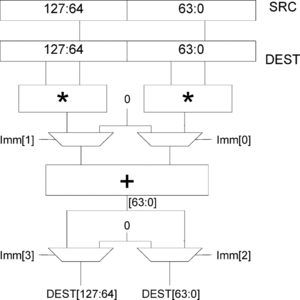Check out my first novel, midnight's simulacra!
SIMD
First introduced on the Illiac IV, and not to be confused with vector processing.
Data Types (taken from SSE specs)
These do not necessarily map to the C data types of the same name, for any given compiler!
- half precision: 16-bit IEEE 754 floating-point (bias-15) (IEEE 754 2008 binary16)
- single: 32-bit IEEE 754 floating-point (bias-127) (IEEE 754 2008 binary32)
- double: 64-bit IEEE 754 floating-point (bias-1023) (IEEE 754 2008 binary64)
- long double: 80-bit "double extended" IEEE 754-1985 floating-point (bias-16383)
- not an actual SIMD type, but an artifact of x87
- word: 32-bit two's complement integer
- doubleword, dword: 64-bit two's complement integer
x86 XMM
SSE5 (AMD)
- Unimplemented extensions competing with SSE4, encoded using a method incompatible with VEX
- Withdrawn, converted into VEX-compatible encodings, and split into:
- FMA4: Fused floating-point multiply-add (compare Intel's FMA)
- XOP: Fused integer multiply-add, byte permutations, shifts, rotates, integer vector horizontal operations (compare Intel's SSE4)
- CVT16: Half-precision conversion
SSE4 (Intel)
SSE4a
SSE4.1

- Introduced on Penryn
- dpps -- dot product of two vectors having four single components each
- dppd -- dot product of two vectors having two double components each
- insertps
SSE4.2
- Introduced on Nehalem
SSE3 (PNI)
- Originally known as Prescott New Instructions, and introduced on P4-Prescott
- movddup -- move a double from a 8-byte-aligned memory location or lower half of XMM register to upper half, then duplicate upper half to lower half
SSSE3 (TNI/MNI)
- Introduced with the Core microarchitecture. Sometimes referred to as Tejas New Instructions or Merom New Instructions
- pmaddwd -- multiply packed words, then horizontally sum pairs, accumulating into doublewords
SSE2
- movapd -- move two packed doubles from a 16-byte-aligned memory location to XMM registers, or vice versa, or between two XMM registers.
- movupd -- movapd safe for unaligned memory references, with far inferior performance.
- mulpd -- multiply two packed doubles. the multiplier is a 16-byte-aligned memory location or XMM register. the target XMM register serves as the multiplicand.
- addpd -- add two packed doubles. the addend is a 16-byte-aligned memory location or XMM register. the target XMM register serves as the augend.
SSE
- movaps -- move four packed singles from a 16-byte-aligned memory location to XMM registers, or vice versa, or between two XMM registers.
- movups -- movaps safe for unaligned memory references, with far inferior performance.
- mulps -- multiply four packed singles. the multiplier is a 16-byte-aligned memory location or XMM register. the target XMM register serves as the multiplicand.
- addps -- add four packed singles. the addend is a 16-byte-aligned memory location or XMM register. the target XMM register serves as the augend.
Future Directions
- AVX (Advanced Vector eXtensions) -- to be introduced on Intel's Sandy Bridge (2010) and AMD's Bulldozer (2011), and implemented within the VEX coding scheme
- The FMA instruction set extension to x86 should hit around 2011, providing floating-point fused multiply-add
- AMD appears to call this FMA4, part of what was SSE5
x87 MMX
MMX (Intel)
3DNow! (AMD)
Other Architectures
- PowerPC implements AltiVec
- SPARC implements VIS, the Visual Instruction Set
- PA-RISC implements MAX, the Multimedia Acceleration eXtensions
- ARM implements NEON
- Alpha implemented MVI, the Motion Video Instructions
- SWAR: SIMD Within a Register (bit-parallel methods)
See Also
- "Why no FMA in AVX in Sandy Bridge?", Intel Developers Forum
- SSE5 guide at AMD
- 2007-04-19 post to http://virtualdub.org, "SSE4 finally adds dot products"